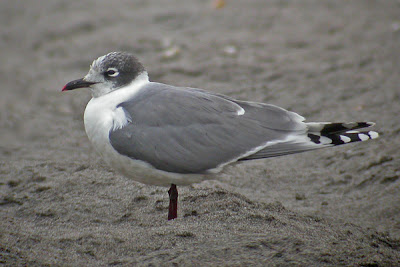The Franklin's Gull that was seen irregularly at Chasewater during the last couple of weeks was thought to have moved on. However, after an absence of four days it roosted there again on Thursday and then, yesterday afternoon, we received a call to say that it had been seen at Gailey Reservoirs, just 14 miles south of here.
When we got there the bird was easily located at the edge of a ploughed field to the north of the reservoir in a mixed flock of gulls that included an adult Yellow-legged. To start with, though, it wasn't very active and was partially obscured by vegetation; eventually, just as we were getting distracted by some Rooks (birds we don’t see in Portugal) and several Brown Hares, it began to walk around a bit and then finally flew over our heads and across the road. It landed on the Lower Pool, in the company of about two dozen Black-headed Gulls, and we watched it there for about 20 minutes. By then about ten other people had arrived - although only the second Franklin’s Gull for Staffordshire, after two weeks in the area its crowd-pulling days are clearly over!
Our chances of photographing it would have been increased significantly if we had taken the 50D + 100-400mm combination. Instead we had only a Lumix FZ-50 with inevitable consequences!
 Next time take the Canon!
Next time take the Canon! Or even a Nikon - this one was digiscoped with a Coolpix 4500 - but in Chile in 2005
Or even a Nikon - this one was digiscoped with a Coolpix 4500 - but in Chile in 2005According to the BOU, the scientific name of Franklin's Gull is still
Larus pipixcan but in 2008, on the basis of genetic data, the American Ornithologists' Union switched the species to the genus
Leucophaeus and so in the Americas it is now referred to a
Leucophaeus pipixcan. This was part of the shake-up of the genus
Larus that also resulted in Slender-billed, Bonaparte's and Black-headed Gulls (amongst others) being assigned to the genus
Chroicocephalus. There was a time, not so long ago, when we became mildly irritated by occasional attempts to change the English names of birds but at least we could rely then on their scientific names being constant. That was before we knew anything about mitochondrial DNA. Now it's hard to keep up!
Incidentally, in case you were wondering, regarding
pipixcan,
A Dictionary of Scientific Bird Names (Jobling 1991) states:
According to Hernandez (1615), Historia avium Novae Hispaniae, pipizcan was the name given by Mexican Indians to a sort of gull (cf. Spanish apipizca, a gull).So now you know!
 Over the years the Birdfair has raised well over £2m for conservation projects. This year the money will go to Ethiopia. More than 40 artists were involved during the three days in painting a huge mural depicting threatened endemic and near-endemic bird species in Ethiopia which will eventually be displayed in the airport in Addis Ababa.
Over the years the Birdfair has raised well over £2m for conservation projects. This year the money will go to Ethiopia. More than 40 artists were involved during the three days in painting a huge mural depicting threatened endemic and near-endemic bird species in Ethiopia which will eventually be displayed in the airport in Addis Ababa.
























